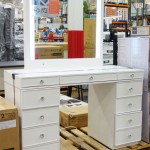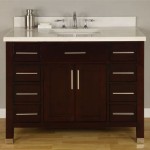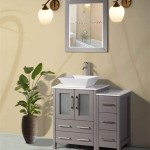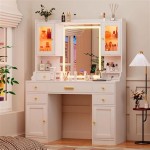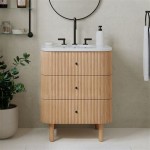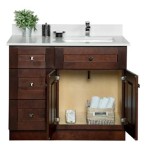Corner Vanity: Maximizing Space in Small Bathrooms
Bathrooms, particularly in older homes or apartments, are often characterized by limited square footage. Efficiently utilizing available space becomes paramount when designing or renovating such a bathroom. A corner vanity presents a practical and aesthetically pleasing solution for optimizing space in small bathrooms, offering both storage and functionality without overwhelming the room.
A corner vanity is a type of bathroom vanity specifically designed to fit snugly into the corner of a room. This unique design maximizes otherwise underutilized space, freeing up valuable floor area for maneuvering and other essential bathroom fixtures. The configuration allows for a sink and storage to be neatly tucked away, creating a more open and less cluttered appearance.
Selecting the right corner vanity requires careful consideration of several factors. These include the dimensions of the available corner, the desired style and finish, the type of sink, and the storage requirements. A well-chosen corner vanity can significantly enhance the functionality and visual appeal of a small bathroom, transforming it into a more comfortable and organized space.
Understanding the Benefits of Corner Vanities
The primary advantage of a corner vanity lies in its space-saving design. By utilizing the corner of a room, which is often left unused, a corner vanity opens up the floor plan, making the bathroom feel larger and more accessible. This is particularly beneficial in bathrooms where every inch counts.
Beyond space optimization, corner vanities offer a range of other benefits. They provide a designated area for washing and grooming, complete with a sink and countertop. The integrated storage, which can include cabinets, drawers, or shelves, keeps toiletries and other bathroom essentials organized and easily accessible. This helps to minimize clutter and maintain a clean and tidy bathroom environment.
Furthermore, corner vanities can contribute to the overall aesthetic appeal of the bathroom. They are available in a wide variety of styles, materials, and finishes, allowing homeowners to choose options that complement the existing décor or create a desired design theme. From sleek and modern to traditional and ornate, there is a corner vanity to suit virtually any taste and preference.
The installation of a corner vanity is generally straightforward, especially for experienced DIY enthusiasts or professional plumbers. However, it is crucial to accurately measure the corner space and ensure that the chosen vanity fits precisely. Proper installation guarantees stability and prevents issues such as water leakage or damage to the surrounding walls.
Key Considerations When Choosing a Corner Vanity
Selecting the appropriate corner vanity involves several crucial considerations. Firstly, accurate measurements of the corner space are essential. This includes the width and depth of the corner, as well as the height of the surrounding walls. These measurements will determine the maximum size of the vanity that can be accommodated without obstructing doorways or other fixtures.
The style and finish of the corner vanity should complement the existing bathroom décor. Consider the color scheme, materials, and overall design aesthetic of the bathroom when making a selection. Common materials for corner vanities include wood, MDF, particleboard, and various synthetic materials. Finishes range from painted surfaces to wood stains and laminates. It's important to select a material and finish that are durable and resistant to moisture, as bathrooms are typically humid environments.
The type of sink is another important factor to consider. Corner vanities can accommodate a variety of sink styles, including drop-in sinks, undermount sinks, vessel sinks, and integrated sinks. The chosen sink style should be compatible with the vanity design and complement the overall aesthetic of the bathroom. Consider the depth and shape of the sink to ensure that it provides sufficient space for washing and grooming.
Storage requirements should also be taken into account. Assess the amount of storage space needed for toiletries, towels, and other bathroom essentials. Corner vanities offer various storage options, including cabinets, drawers, and shelves. Choose a vanity with a storage configuration that meets specific needs and helps to maintain an organized bathroom environment.
Finally, consider the plumbing requirements. Ensure that the corner vanity is compatible with the existing plumbing system, including the water supply lines and drainpipe. If necessary, consult with a plumber to ensure proper installation and avoid any plumbing issues.
Exploring Different Styles and Designs of Corner Vanities
Corner vanities are available in a diverse range of styles and designs to suit various aesthetic preferences and bathroom décor themes. Modern corner vanities often feature clean lines, minimalist designs, and sleek finishes. These vanities may incorporate materials such as glass, metal, and engineered stone to create a contemporary look. They often prioritize functionality and storage space, with features such as soft-close drawers and integrated lighting.
Traditional corner vanities, on the other hand, typically feature more ornate details, such as raised panel doors, decorative hardware, and intricate carvings. These vanities may be made from solid wood or wood veneers and finished with rich stains or antique glazes. They often evoke a sense of classic elegance and timeless appeal.
Transitional corner vanities blend elements of both modern and traditional design. They may feature clean lines and simple shapes combined with traditional details, such as raised panel doors or decorative hardware. These vanities often incorporate neutral colors and natural materials to create a balanced and versatile look.
Floating corner vanities are mounted directly to the wall, creating a sense of openness and space. These vanities are particularly well-suited for small bathrooms where maximizing floor space is a priority. They often feature minimalist designs and clean lines and can be customized with various storage options.
Corner vanities are also available in a variety of colors and finishes. White is a popular choice for bathrooms, as it creates a bright and airy feel. Other neutral colors, such as gray, beige, and cream, are also versatile options that can complement a variety of décor styles. For those who prefer a bolder look, corner vanities are available in a range of vibrant colors, such as blue, green, and red. The finish of the vanity can also impact its overall appearance. Common finishes include matte, glossy, and textured surfaces.
In addition to the style, material, and finish, the countertop material also plays a significant role in the overall design of the corner vanity. Popular countertop materials include granite, marble, quartz, solid surface, and laminate. Each material offers its own unique advantages in terms of durability, aesthetics, and cost. Granite and marble are natural stone options that offer a luxurious and timeless appeal. Quartz is an engineered stone that is highly durable and resistant to stains and scratches. Solid surface materials are non-porous and seamless, making them easy to clean and maintain. Laminate is a cost-effective option that is available in a wide range of colors and patterns.
The hardware on the corner vanity, such as knobs and pulls, can also contribute to its overall style. Choose hardware that complements the design of the vanity and the rest of the bathroom décor. Common hardware materials include brushed nickel, chrome, brass, and oil-rubbed bronze.
Lighting is another important consideration when designing a corner vanity. Adequate lighting is essential for grooming and applying makeup. Consider installing sconces on either side of the vanity mirror or adding a recessed light above the vanity. A well-lit vanity can enhance the functionality and visual appeal of the bathroom.
The backsplash behind the corner vanity can also add to its overall style and protect the wall from water damage. Choose a backsplash material that complements the vanity and the rest of the bathroom décor. Common backsplash materials include ceramic tile, glass tile, and stone tile.
By carefully considering the style, material, finish, countertop, hardware, lighting, and backsplash, it is possible to create a corner vanity that is both functional and aesthetically pleasing. A well-designed corner vanity can transform a small bathroom into a stylish and organized space.

Home Decorators Collection Aberdeen 32 In Single Sink Corner White Bath Vanity With Carrara Marble Top Assembled 32w

Space Saving Corner Bathroom Vanity Ideas

24 Inch Triadsville Taupe Corner Design Bathroom Vanity With Quartz Top

Corner Bathroom Vanity Ideas My Renovations

Bathroom Vanity Unit Free Standing Oak Corner Cabinet Golden Onyx Top Basin 501bgo25go Etsy

Small Corner 12 8 In W X D 22 H Single Sink Wall Mount Bath Vanity Blue With White Ceramic Top

Corner Bathroom Vanity Ideas 18 Designs For Any Space Decoist

Tennant Brand 24 White Corner Bathroom Vanity And Quartz Top

13 Inch Plywood Corner Wall Mounted Bathroom Vanity With Top Integrated Ceramic Sink Soft Close Door In Navy Blue

Wall Mounted Corner Bathroom Vanity Cabinet Triangular Abstract Sink White 15 L X W 16 5 H Faucet Mirrors
